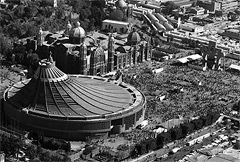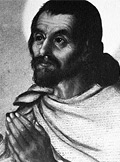|
|
|
|
|
|
|
|

A regular feature of The Catholic New World, the InterVIEW is an in-depth conversation with a person whose words, actions or ideas affect today’s Catholic. It may be affirming of faith or confrontational. But it will always be stimulating.
|
|
Asking, on eve of canonization, ‘why Diego?’
Juan Diego is known as the visionary indigenous Mexican whose faith sparked the devotion to Our Lady of Guadalupe centuries ago and who now stands on the brink of sainthood. Pope John Paul II is scheduled to visit Mexico City in late July and celebrate his canonization.
Among the people who helped to make the upcoming canonization possible are Mexico City priests Father José Luis Guerrero and Father Eduardo Chávez. The pair recently spoke with Zenit, a news service with ties to the Vatican, about the importance of the canonization of the 16th-century Indian.
 
Blessed Juan Diego, pictured on a prayer card at right, will be canonized July 30 at the Basilica of Our Lady of Guadalupe (left) in Mexico City. CNS
Zenit: Many people find it odd that Juan Diego’s sanctity is only being recognized now, and that his process of canonization in recent years has been “so fast,” as if there is urgency to make him a saint. What is your opinion?
Father Eduardo Chávez: Certainly, in recent times Juan Diego’s life has been studied more for his canonization, but as early as the 16th century, he was regarded as an intercessor with the Virgin, and since the 17th century, he has been regarded as a saint or worthy of the altar.
In fact, many of our Mexican ancestors thought Juan Diego was already in heaven. As regards the canonization itself, it is a “politically correct” process of canonical normatives; I should say that the last stage of the study lasted close to 22 years.
Z: One of the objections made to Juan Diego by historians and even people of the church is that a good part of the information on his historicity is of a very late date, already well into the 17th century. How were you able to sort out the facts?
FEC: Many of the 17th-century witnesses were very elderly people who recounted what their forebears told them. It could easily be that their grandparents were Juan Diego’s contemporaries.
And one must add that the evidence of the 17th century also comes from authorities of the most important religious orders, all under oath to tell the truth about what was transmitted to them by their ancestors. In 1746, Cayetano Cabrera recounted how Juan Diego’s contemporaries regarded him as a saint and intercessor before the Virgin of Guadalupe, and from that time exclaimed: “We hope that one day Juan Diego will merit the altar.”
Father José Luis Guerrero: This testimony is one of many, but one can say without the shadow of a doubt that for 16th-, 17th- and 18th-century Mexicans, Juan Diego’s historicity was something absolutely normal. Ignacio Manuel Altamirano, a 19th-century liberal, who spoke Mexican, said that he heard songs in Mexican in Tepeyac to the Virgin of Guadalupe by pure Indians from the high plateau. Because of this, Altamirano said that “every Mexican is a Juan Diego.”
Z: In terms of documents, how is the whole of Juan Diego’s historicity upheld?
FEC: It is not based on a document; there are many documents of all kinds, written and oral. Among the written, there are manuscripts, wills, legal certificates, archaeological evidence, etc., which are interrelated in such a way that, little by little, they unfold history. The convergence of sources is very clear in Juan Diego’s case. Moreover, in no way have we underrated the oral tradition.
Z: Juan Diego’s process of canonization was too connected to an outside agenda, namely, to the agenda imposed by the media or even by personalities of the church itself as, for example, the former abbot of the Basilica of Guadalupe, Guillermo Schulenburg, who publicly denied Juan Diego’s historicity. How did those of you who were promoting the process see this?
FEC: All saints have had people against them. Viewed in perspective, when little time is left before Juan Diego is canonized, it was very helpful for research and to give replies.
The work of the Congregation for the Causes of Saints on Juan Diego is sufficient, full, complete. It is very proper and honest. “The devil’s advocate” is that figure who, from within, makes things be thoroughly supported, from the very core of any given individual.
However, this outside agenda had a double blade: On the one hand, it did impel us to consolidate our research but, on the other, it robbed us of precious time in having to answer thousands of objections that were made to us.
FJLG: Form 13 of the Causes of Saints orders a discussion on any objection made to a process; it must be sent to the postulation for resolution. We were involved in such confusion, which most of the time was stupid.
FEC: Frankly, I never imagined that I would have to study whether or not Juan Diego had a beard, but even this we had to answer to what you call the “outside agenda.” However, what they hoped to do was to create a climate of confusion, which would underrate the heroism of the future hero of the church.
FJLG: It is the same technique used in past centuries to deny the Gospel.
Z: What do you mean?
FEC: If I am told that St. Francis of Assisi did not exist, I am disturbed; it destroys a sector of the church, but it does not destroy the church itself. If I am told that St. Teresa was a fantasy created by a community, well, I am disturbed; but they cannot destroy the church for me. But if they tell me that Matthew, Mark, Luke and John are a nonexistent fantasy, then Jesus is a fantasy, and the church is a joke. Within due proportion, this is the key to understanding the attacks on Juan Diego.
Z: Hence, profound issues are at stake in Juan Diego’s canonization, perhaps more profound than we think.
FEC: Indeed, this canonization states that God does, indeed, intervene in man’s history, and he intervenes with what is most beautiful to him, his Most Holy Mother. He intervenes in this way with us, and through us, in the whole world. In addition to being a message for Mexico, the message of Guadalupe is a message for the whole world; a message of unity, of harmony, of miscegenation in the good sense of the word.
top
Front Page | Digest | Cardinal | Interview
Classifieds | About Us | Write Us | Subscribe | Advertise
Archive | Catholic Sites | New World Publications | Católico | Directory | Site Map
Subscribe to the the Catholic New World
|







